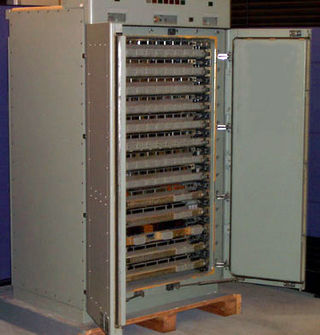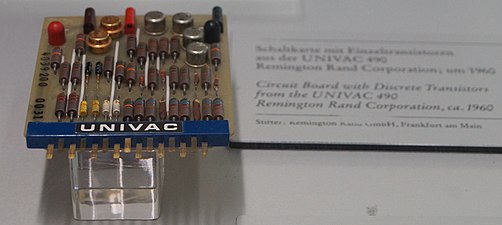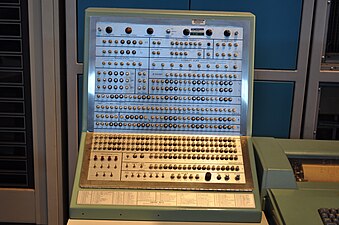In computer science, an instruction set architecture (ISA) is an abstract model that generally defines how software controls the CPU in a computer or a family of computers. A device or program that executes instructions described by that ISA, such as a central processing unit (CPU), is called an implementation of that ISA.

UNIVAC was a line of electronic digital stored-program computers starting with the products of the Eckert–Mauchly Computer Corporation. Later the name was applied to a division of the Remington Rand company and successor organizations.
The AN/USQ-17 or Naval Tactical Data System (NTDS) computer referred to in Sperry Rand documents as the Univac M-460, was Seymour Cray's last design for UNIVAC. UNIVAC later released a commercial version, the UNIVAC 490. That system was later upgraded to a multiprocessor configuration as the 494.

The AN/USQ-20, or CP-642 or Naval Tactical Data System (NTDS), was designed as a more reliable replacement for the Seymour Cray-designed AN/USQ-17 with the same instruction set. The first batch of 17 computers were delivered to the Navy starting in early 1961.
The AN/UYK-8 was a UNIVAC computer.
FASTRAND was a magnetic drum mass storage system built by Sperry Rand Corporation for their UNIVAC 1100 series and 418/490/494 series computers. A FASTRAND subsystem consisted of one or two Control Units and up to eight FASTRAND units. A dual-access FASTRAND subsystem included two complete control units, and provided parallel data paths that allowed simultaneous operations on any two FASTRAND units in the subsystem. Each control unit interfaced to one 1100 Series (36-bit), or 490 Series (30-bit), parallel I/O channels.

The UNIVAC 1100/2200 series is a series of compatible 36-bit computer systems, beginning with the UNIVAC 1107 in 1962, initially made by Sperry Rand. The series continues to be supported today by Unisys Corporation as the ClearPath Dorado Series. The solid-state 1107 model number was in the same sequence as the earlier vacuum-tube computers, but the early computers were not compatible with their solid-state successors.

The UNIVAC 1103 or ERA 1103, a successor to the UNIVAC 1101, is a computer system designed by Engineering Research Associates and built by the Remington Rand corporation in October 1953. It was the first computer for which Seymour Cray was credited with design work.

An index register in a computer's CPU is a processor register used for pointing to operand addresses during the run of a program. It is useful for stepping through strings and arrays. It can also be used for holding loop iterations and counters. In some architectures it is used for read/writing blocks of memory. Depending on the architecture it may be a dedicated index register or a general-purpose register. Some instruction sets allow more than one index register to be used; in that case additional instruction fields may specify which index registers to use.
Tomasulo's algorithm is a computer architecture hardware algorithm for dynamic scheduling of instructions that allows out-of-order execution and enables more efficient use of multiple execution units. It was developed by Robert Tomasulo at IBM in 1967 and was first implemented in the IBM System/360 Model 91’s floating point unit.

The CDC 7600 was designed by Seymour Cray to be the successor to the CDC 6600, extending Control Data's dominance of the supercomputer field into the 1970s. The 7600 ran at 36.4 MHz and had a 65 Kword primary memory using magnetic core and variable-size secondary memory. It was generally about ten times as fast as the CDC 6600 and could deliver about 10 MFLOPS on hand-compiled code, with a peak of 36 MFLOPS. In addition, in benchmark tests in early 1970 it was shown to be slightly faster than its IBM rival, the IBM System/360, Model 195. When the system was released in 1967, it sold for around $5 million in base configurations, and considerably more as options and features were added.

The CDC STAR-100 is a vector supercomputer that was designed, manufactured, and marketed by Control Data Corporation (CDC). It was one of the first machines to use a vector processor to improve performance on appropriate scientific applications. It was also the first supercomputer to use integrated circuits and the first to be equipped with one million words of computer memory.

CMS-2 is an embedded systems programming language used by the United States Navy. It was an early attempt to develop a standardized high-level computer programming language intended to improve code portability and reusability. CMS-2 was developed primarily for the US Navy’s tactical data systems (NTDS).
The UNIVAC 418 was a transistorized, 18-bit word magnetic-core memory machine made by Sperry Univac. The name came from its 4-microsecond memory cycle time and 18-bit word. The assembly language for this class of computers was TRIM III and ART418.
Bit slicing is a technique for constructing a processor from modules of processors of smaller bit width, for the purpose of increasing the word length; in theory to make an arbitrary n-bit central processing unit (CPU). Each of these component modules processes one bit field or "slice" of an operand. The grouped processing components would then have the capability to process the chosen full word-length of a given software design.

The CDC 1604 is a 48-bit computer designed and manufactured by Seymour Cray and his team at the Control Data Corporation (CDC). The 1604 is known as one of the first commercially successful transistorized computers. Legend has it that the 1604 designation was chosen by adding CDC's first street address to Cray's former project, the ERA-UNIVAC 1103.

In computing, an arithmetic logic unit (ALU) is a combinational digital circuit that performs arithmetic and bitwise operations on integer binary numbers. This is in contrast to a floating-point unit (FPU), which operates on floating point numbers. It is a fundamental building block of many types of computing circuits, including the central processing unit (CPU) of computers, FPUs, and graphics processing units (GPUs).
The ones' complement of a binary number is the value obtained by inverting (flipping) all the bits in the binary representation of the number. The name "ones' complement" refers to the fact that such an inverted value, if added to the original, would always produce an "all ones" number. This mathematical operation is primarily of interest in computer science, where it has varying effects depending on how a specific computer represents numbers.

The Univac Buffer Processor (BP) was used in several real-time computer system installations in the 1960s as a network concentrator and front end system to the UNIVAC 418 and UNIVAC 490/494 real-time systems.














